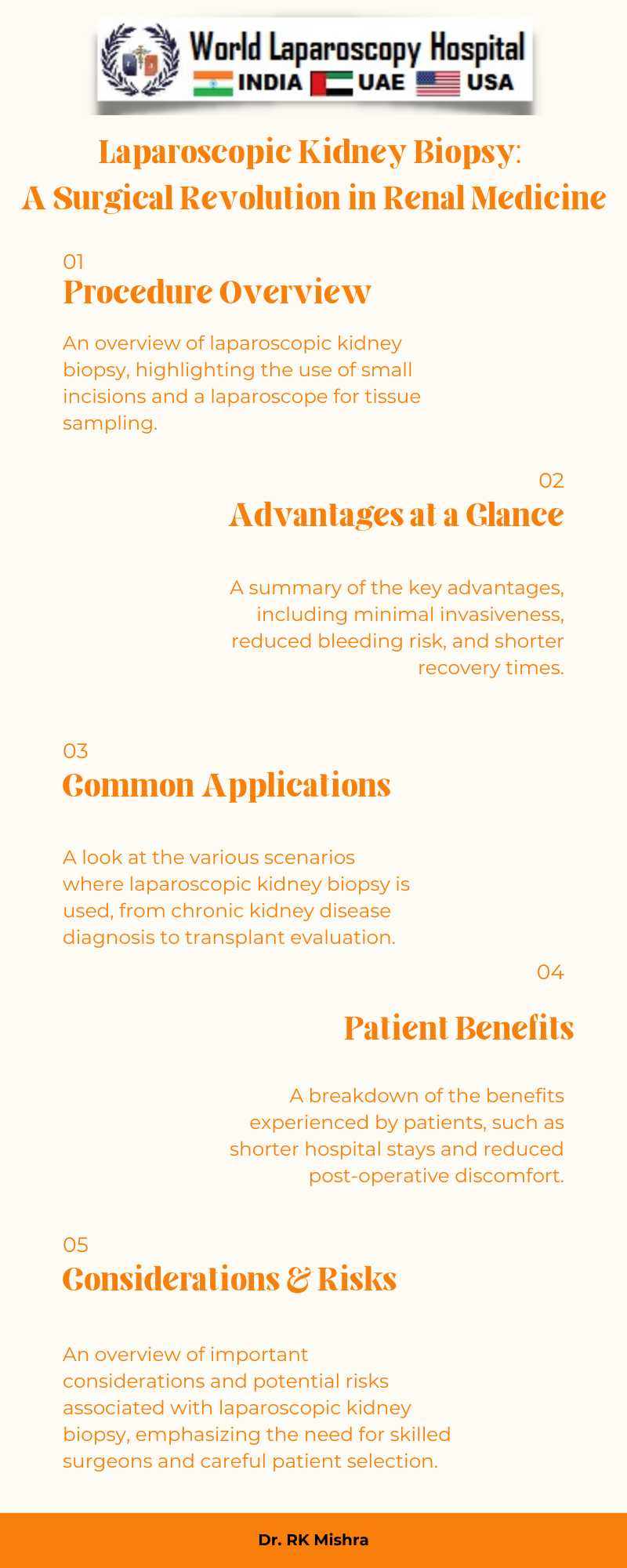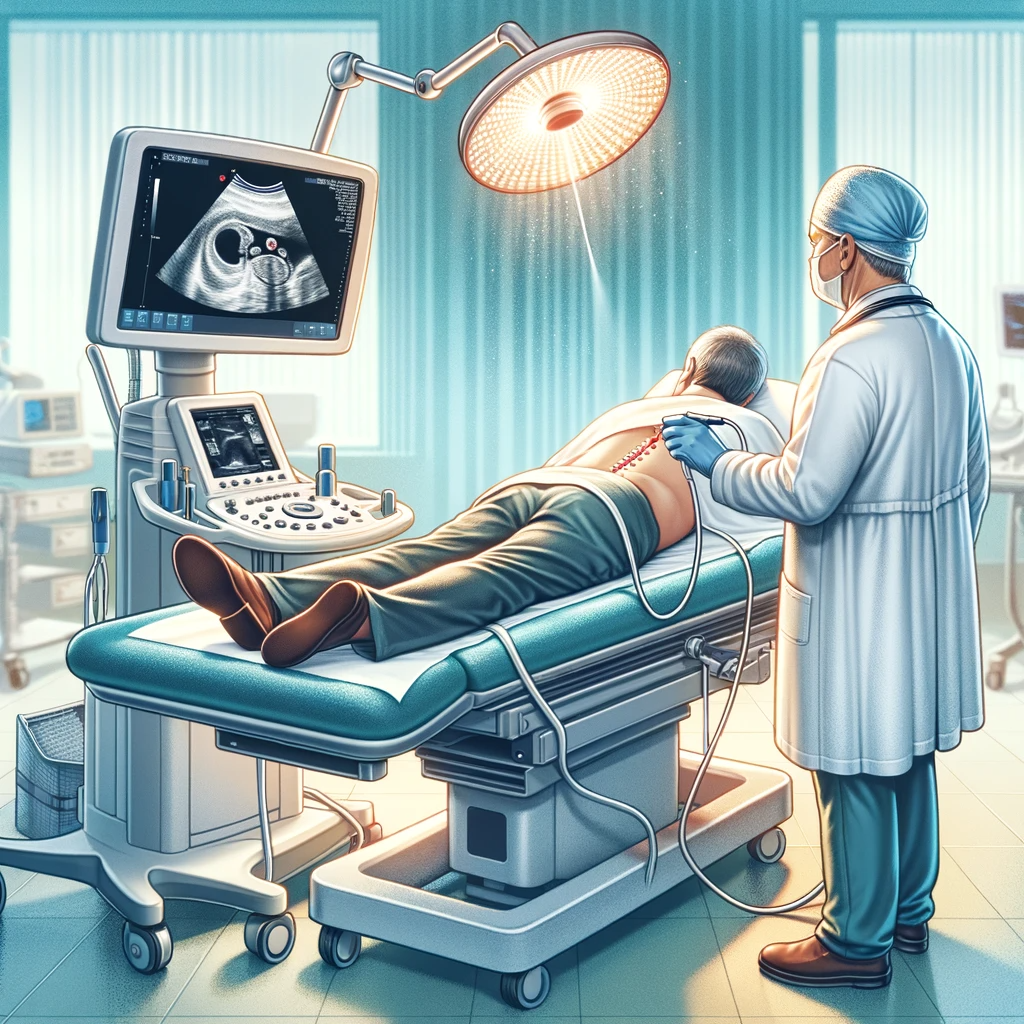Laparoscopic Kidney Biopsy: A Surgical Revolution in Renal Medicine
Laparoscopic Kidney Biopsy: A Surgical Revolution in Renal Medicine
Introduction:
The field of medicine is constantly evolving, with advancements in technology and techniques leading to improved patient outcomes and reduced invasiveness in procedures. One such advancement that has made a significant impact on renal medicine is laparoscopic kidney biopsy. This minimally invasive surgical approach has revolutionized the way we diagnose and treat kidney diseases. In this article, we will explore the history, technique, advantages, and applications of laparoscopic kidney biopsy, shedding light on how it has become a surgical revolution in renal medicine.

The Evolution of Kidney Biopsy
Before delving into the world of laparoscopic kidney biopsy, it's essential to understand the evolution of kidney biopsy techniques. Kidney biopsy, as a diagnostic procedure, has a long history dating back to the early 20th century. Initially, open surgical kidney biopsy was the standard method for obtaining renal tissue samples. This invasive approach required a larger incision, extended recovery time, and had a higher risk of complications.
In the 1970s, percutaneous kidney biopsy emerged as a less invasive alternative. This procedure involved using a needle to extract renal tissue through the skin. While percutaneous kidney biopsy reduced the invasiveness compared to open surgery, it still had limitations, including the risk of bleeding and the need for skilled operators.
Laparoscopic kidney biopsy, which became popular in the late 20th century, marked a significant leap forward in renal medicine. This minimally invasive technique offers several advantages over its predecessors.
The Laparoscopic Kidney Biopsy Technique
Laparoscopic kidney biopsy involves the use of small incisions and a laparoscope, a thin tube with a camera and light source, to visualize and obtain tissue samples from the kidney. Here's a step-by-step overview of the procedure:
1. Anesthesia: The patient is placed under general anesthesia to ensure they are pain-free and unconscious during the procedure.
2. Incisions: Typically, three small incisions (about 1 cm each) are made in the abdominal wall. These serve as entry points for the laparoscope and specialized surgical instruments.
3. Visualization: The laparoscope is inserted through one of the incisions, providing a clear view of the kidney on a monitor in the operating room.
4. Biopsy: Using the laparoscope and other instruments, the surgeon carefully collects tissue samples from the kidney. Multiple samples may be taken to ensure an accurate diagnosis.
5. Closure: Once the biopsy is complete, the instruments are removed, and the incisions are closed with sutures or adhesive.
Advantages of Laparoscopic Kidney Biopsy
Laparoscopic kidney biopsy offers several key advantages that have contributed to its status as a surgical revolution in renal medicine:
1. Minimally Invasive: Laparoscopic kidney biopsy is minimally invasive compared to open surgery, resulting in smaller incisions, less pain, and a shorter recovery period.
2. Precision: The laparoscope provides a magnified view of the kidney, allowing for precise tissue sampling and reduced risk of complications.
3. Reduced Bleeding Risk: The minimally invasive approach minimizes the risk of significant bleeding during the procedure.
4. Shorter Hospital Stay: Patients typically spend less time in the hospital after laparoscopic kidney biopsy, promoting a quicker return to normal activities.
5. Diagnostic Accuracy: Laparoscopic kidney biopsy provides high-quality tissue samples for accurate diagnosis of various kidney conditions, including glomerulonephritis, interstitial nephritis, and renal tumors.

Applications of Laparoscopic Kidney Biopsy
Laparoscopic kidney biopsy has found applications in various renal conditions and scenarios:
1. Chronic Kidney Disease: It plays a crucial role in diagnosing and staging chronic kidney disease, guiding treatment decisions.
2. Kidney Transplantation: Laparoscopic kidney biopsy is essential in evaluating the suitability of donor kidneys for transplantation.
3. Renal Mass Evaluation: It aids in the diagnosis of renal masses, helping determine whether they are benign or malignant.
4. Research and Clinical Trials: Laparoscopic kidney biopsy provides researchers with high-quality tissue samples for studies and clinical trials aimed at advancing our understanding of kidney diseases and developing new treatments.
5. Pediatric Nephrology: The minimally invasive nature of laparoscopic kidney biopsy is particularly beneficial in pediatric patients, reducing trauma and promoting faster recovery.
Challenges and Considerations
While laparoscopic kidney biopsy offers numerous advantages, it is not without challenges and considerations. These include:
1. Operator Skill: Performing laparoscopic kidney biopsy requires a high level of surgical skill and expertise.
2. Risk of Complications: Although the risk is lower than with open surgery, laparoscopic kidney biopsy can still lead to complications such as bleeding, infection, and injury to surrounding structures.
3. Patient Selection: Not all patients are suitable candidates for laparoscopic kidney biopsy, and careful patient selection is necessary.
4. Cost: The equipment and expertise required for laparoscopic kidney biopsy may lead to higher costs compared to other biopsy methods.
Conclusion:
Laparoscopic kidney biopsy has emerged as a surgical revolution in renal medicine, transforming the way we diagnose and treat kidney diseases. Its minimally invasive nature, precision, and diagnostic accuracy have made it a preferred choice for both clinicians and patients. As technology continues to advance, further refinements in laparoscopic techniques and equipment are likely, promising even better outcomes for individuals with kidney-related conditions. This procedure represents a significant milestone in the journey toward improving the lives of patients with kidney diseases, underscoring the importance of ongoing research and innovation in the field of renal medicine.
Introduction:
The field of medicine is constantly evolving, with advancements in technology and techniques leading to improved patient outcomes and reduced invasiveness in procedures. One such advancement that has made a significant impact on renal medicine is laparoscopic kidney biopsy. This minimally invasive surgical approach has revolutionized the way we diagnose and treat kidney diseases. In this article, we will explore the history, technique, advantages, and applications of laparoscopic kidney biopsy, shedding light on how it has become a surgical revolution in renal medicine.

The Evolution of Kidney Biopsy
Before delving into the world of laparoscopic kidney biopsy, it's essential to understand the evolution of kidney biopsy techniques. Kidney biopsy, as a diagnostic procedure, has a long history dating back to the early 20th century. Initially, open surgical kidney biopsy was the standard method for obtaining renal tissue samples. This invasive approach required a larger incision, extended recovery time, and had a higher risk of complications.
In the 1970s, percutaneous kidney biopsy emerged as a less invasive alternative. This procedure involved using a needle to extract renal tissue through the skin. While percutaneous kidney biopsy reduced the invasiveness compared to open surgery, it still had limitations, including the risk of bleeding and the need for skilled operators.
Laparoscopic kidney biopsy, which became popular in the late 20th century, marked a significant leap forward in renal medicine. This minimally invasive technique offers several advantages over its predecessors.
The Laparoscopic Kidney Biopsy Technique
Laparoscopic kidney biopsy involves the use of small incisions and a laparoscope, a thin tube with a camera and light source, to visualize and obtain tissue samples from the kidney. Here's a step-by-step overview of the procedure:
1. Anesthesia: The patient is placed under general anesthesia to ensure they are pain-free and unconscious during the procedure.
2. Incisions: Typically, three small incisions (about 1 cm each) are made in the abdominal wall. These serve as entry points for the laparoscope and specialized surgical instruments.
3. Visualization: The laparoscope is inserted through one of the incisions, providing a clear view of the kidney on a monitor in the operating room.
4. Biopsy: Using the laparoscope and other instruments, the surgeon carefully collects tissue samples from the kidney. Multiple samples may be taken to ensure an accurate diagnosis.
5. Closure: Once the biopsy is complete, the instruments are removed, and the incisions are closed with sutures or adhesive.
Advantages of Laparoscopic Kidney Biopsy
Laparoscopic kidney biopsy offers several key advantages that have contributed to its status as a surgical revolution in renal medicine:
1. Minimally Invasive: Laparoscopic kidney biopsy is minimally invasive compared to open surgery, resulting in smaller incisions, less pain, and a shorter recovery period.
2. Precision: The laparoscope provides a magnified view of the kidney, allowing for precise tissue sampling and reduced risk of complications.
3. Reduced Bleeding Risk: The minimally invasive approach minimizes the risk of significant bleeding during the procedure.
4. Shorter Hospital Stay: Patients typically spend less time in the hospital after laparoscopic kidney biopsy, promoting a quicker return to normal activities.
5. Diagnostic Accuracy: Laparoscopic kidney biopsy provides high-quality tissue samples for accurate diagnosis of various kidney conditions, including glomerulonephritis, interstitial nephritis, and renal tumors.

Applications of Laparoscopic Kidney Biopsy
Laparoscopic kidney biopsy has found applications in various renal conditions and scenarios:
1. Chronic Kidney Disease: It plays a crucial role in diagnosing and staging chronic kidney disease, guiding treatment decisions.
2. Kidney Transplantation: Laparoscopic kidney biopsy is essential in evaluating the suitability of donor kidneys for transplantation.
3. Renal Mass Evaluation: It aids in the diagnosis of renal masses, helping determine whether they are benign or malignant.
4. Research and Clinical Trials: Laparoscopic kidney biopsy provides researchers with high-quality tissue samples for studies and clinical trials aimed at advancing our understanding of kidney diseases and developing new treatments.
5. Pediatric Nephrology: The minimally invasive nature of laparoscopic kidney biopsy is particularly beneficial in pediatric patients, reducing trauma and promoting faster recovery.
Challenges and Considerations
While laparoscopic kidney biopsy offers numerous advantages, it is not without challenges and considerations. These include:
1. Operator Skill: Performing laparoscopic kidney biopsy requires a high level of surgical skill and expertise.
2. Risk of Complications: Although the risk is lower than with open surgery, laparoscopic kidney biopsy can still lead to complications such as bleeding, infection, and injury to surrounding structures.
3. Patient Selection: Not all patients are suitable candidates for laparoscopic kidney biopsy, and careful patient selection is necessary.
4. Cost: The equipment and expertise required for laparoscopic kidney biopsy may lead to higher costs compared to other biopsy methods.
Conclusion:
Laparoscopic kidney biopsy has emerged as a surgical revolution in renal medicine, transforming the way we diagnose and treat kidney diseases. Its minimally invasive nature, precision, and diagnostic accuracy have made it a preferred choice for both clinicians and patients. As technology continues to advance, further refinements in laparoscopic techniques and equipment are likely, promising even better outcomes for individuals with kidney-related conditions. This procedure represents a significant milestone in the journey toward improving the lives of patients with kidney diseases, underscoring the importance of ongoing research and innovation in the field of renal medicine.
2 COMMENTS
Dr. Harish Shukla
#1
Nov 26th, 2023 8:38 am
Medicine's evolution brings forth advancements like laparoscopic kidney biopsy, revolutionizing renal care. This minimally invasive approach transforms diagnosis and treatment of kidney diseases, showcasing its history, technique, advantages, and applications in this enlightening article.
Dr. David Heath
#2
Dec 3rd, 2023 9:49 am
Medicine evolves with technological advancements, improving patient outcomes and reducing invasiveness. Laparoscopic kidney biopsy stands as a significant advancement, revolutionizing the diagnosis and treatment of kidney diseases. Explore its history, technique, advantages, and applications in this enlightening article.
| Older Post | Home | Newer Post |





